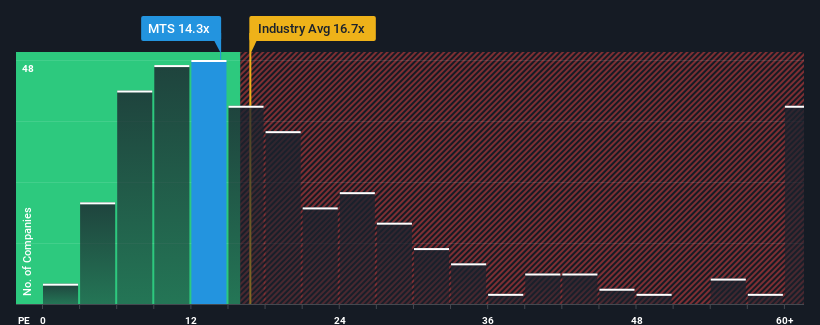- Australia
- /
- Food and Staples Retail
- /
- ASX:MTS
Little Excitement Around Metcash Limited's (ASX:MTS) Earnings
Metcash Limited's (ASX:MTS) price-to-earnings (or "P/E") ratio of 14.3x might make it look like a buy right now compared to the market in Australia, where around half of the companies have P/E ratios above 19x and even P/E's above 37x are quite common. However, the P/E might be low for a reason and it requires further investigation to determine if it's justified.
Recent times have been pleasing for Metcash as its earnings have risen in spite of the market's earnings going into reverse. One possibility is that the P/E is low because investors think the company's earnings are going to fall away like everyone else's soon. If you like the company, you'd be hoping this isn't the case so that you could potentially pick up some stock while it's out of favour.
View our latest analysis for Metcash

What Are Growth Metrics Telling Us About The Low P/E?
There's an inherent assumption that a company should underperform the market for P/E ratios like Metcash's to be considered reasonable.
Retrospectively, the last year delivered a decent 13% gain to the company's bottom line. The solid recent performance means it was also able to grow EPS by 13% in total over the last three years. Therefore, it's fair to say the earnings growth recently has been respectable for the company.
Turning to the outlook, the next three years should generate growth of 3.6% per year as estimated by the twelve analysts watching the company. That's shaping up to be materially lower than the 17% each year growth forecast for the broader market.
With this information, we can see why Metcash is trading at a P/E lower than the market. It seems most investors are expecting to see limited future growth and are only willing to pay a reduced amount for the stock.
What We Can Learn From Metcash's P/E?
Typically, we'd caution against reading too much into price-to-earnings ratios when settling on investment decisions, though it can reveal plenty about what other market participants think about the company.
We've established that Metcash maintains its low P/E on the weakness of its forecast growth being lower than the wider market, as expected. At this stage investors feel the potential for an improvement in earnings isn't great enough to justify a higher P/E ratio. It's hard to see the share price rising strongly in the near future under these circumstances.
It is also worth noting that we have found 2 warning signs for Metcash that you need to take into consideration.
If you're unsure about the strength of Metcash's business, why not explore our interactive list of stocks with solid business fundamentals for some other companies you may have missed.
New: Manage All Your Stock Portfolios in One Place
We've created the ultimate portfolio companion for stock investors, and it's free.
• Connect an unlimited number of Portfolios and see your total in one currency
• Be alerted to new Warning Signs or Risks via email or mobile
• Track the Fair Value of your stocks
Have feedback on this article? Concerned about the content? Get in touch with us directly. Alternatively, email editorial-team (at) simplywallst.com.
This article by Simply Wall St is general in nature. We provide commentary based on historical data and analyst forecasts only using an unbiased methodology and our articles are not intended to be financial advice. It does not constitute a recommendation to buy or sell any stock, and does not take account of your objectives, or your financial situation. We aim to bring you long-term focused analysis driven by fundamental data. Note that our analysis may not factor in the latest price-sensitive company announcements or qualitative material. Simply Wall St has no position in any stocks mentioned.
About ASX:MTS
Metcash
Operates as a wholesale distribution and marketing company in Australia.
Undervalued with excellent balance sheet.
Similar Companies
Market Insights
Community Narratives



